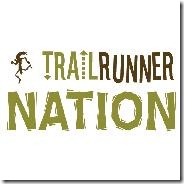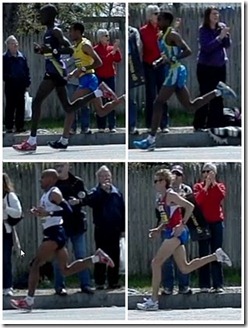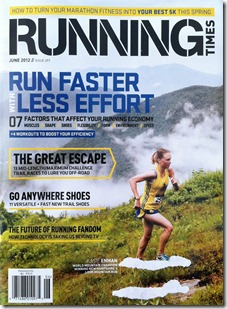 A few weeks ago I announced that an excerpt from my book, Tread Lightly, appears in the June issue of Running Times Magazine. The article, titled Facts on Foot Strike, was just release live on the Running Times website (with free access) – you can read it by clicking this link.
A few weeks ago I announced that an excerpt from my book, Tread Lightly, appears in the June issue of Running Times Magazine. The article, titled Facts on Foot Strike, was just release live on the Running Times website (with free access) – you can read it by clicking this link.
The article looks at the differences between heel striking and forefoot striking in terms of the forces applied to the foot and leg, and how these might relate to injury risk. The excerpt represents a small piece of a larger chapter on the broad topic of the running foot strike. And if nothing else, you’ll learn why a forefoot striker is like a monster truck!
Once again, to read Facts on Foot Strike, click here.

















Pete,
When is Amazon going to start selling the ebook version of Tread Lightly?
Brad
Don’t have a date, but assume it will not be long.
Pete
—-
Pete Larson’s Web Links:
My book: Tread Lightly – Form Footwear and the Quest For Injury Free Running<http: 1616083743=”” gp=”” product=”” ref=”as_li_ss_tl?ie=UTF8&tag=thviofli-20&linkCode=as2&camp=1789&creative=390957&creativeASIN=1616083743″ http://www.amazon.com=“”> Work: link to anselm.edu…
Blog: https://runblogger.com
Dailymile Profile: link to dailymile.com…
Twitter: link to twitter.com</http:>
Pete, out of curiosity, what shoe is the runner wearing on the cover of Tread Lightly? The copyright page says the photo is courtesy of Merrell, so I assume it’s a Merrell shoe (and a women’s shoe at that given the model is a woman), but I couldn’t seem to find that shoe on their site.
Merrell Dash Glove – my wife is running in it now, sweet looking shoe.
Pete,
Got your book last Wednesday and finished it this weekend. I have some initial thoughts and a question.
First my thoughts…
When I started reading, at the first chapter of course, I was afraid the book was going to be yet another in a long list detailing the history of the human race as hunters/gatherers. I mean really – how many more books do we need telling us that humans didn’t have pizza delivery in cave-man times and we had to go out and hunt for our food? However, as I kept reading, I was glad that you got to the “real” subject matter pretty quickly and the foundational details of us being hunters and gatherers were relevant throughout the rest of the book as you provided details on your and other’s research. Speaking of research – this, in my opinion, is the strongest part of your book. You, along with your support team, provided easily digestible details on previous research. Some of which, frankly, was surprising that these topics were discussed and analyzed so long ago. All-in-all, your book was a very good read, especially for running-geeks like me.
Now for the question…
If you were a cross-country coach, say at a high school, how would you guide your athletes to getting properly fit with training shoes with the goal of this being one part of minimizing the occurrence of injury? After reading your book – one strategy would be to tell the athletes to avoid, at all cost, motion-control shoes. And if you pronate heavily – get neutral cushion shoes, and if you are a neutral runner, go with stability shoes. The last part, of course, is the opposite of what has been told to many runners at specialty stores for years – but the statistics provided in your book show that this is one possible option. Anyway, your thoughts on this question will be very much appreciated. By the way – in past years, I’ve scheduled a team night for my athletes at the beginning of each season and let the “experts” at a local running specialty store do their thing.
On a personal note – I’d like to share one bit of form detail. As a high school cross-country coach, I find that one of the best things I can do to help my athletes is to run myself. That way, as they have questions about form, mileage, cross-training, diet, training shoes, etc… I am better able to understand what they are asking and can provide answers based not only on what I’ve seen in athlete over the years – but my own personal experiences too. One of which is an area I’ve struggled with since I was in high school almost 30 years ago. Specifically – severely rolling my ankles while on wooded trails. I thought for many years it was either my shoes or weak ankles or that I wasn’t paying close enough attention to where I was placing my foot on each and every stride. As it turns out, the solution for me was to avoid heal-striking at all cost – no matter the pace. When my mid-foot falls just in-front of my center of gravity (by an inch or two) and I hit an unexpected root or rock, instead of my ankle rolling to a 90 degree angle (yes…I’ve rolled it that bad numerous times), it now rolls at most 45 degrees and has little adverse affect. This is, as best I can tell, because I’m not initially hitting the breaks with an over-stride and my foot is more in a neutral, or close to a propulsive, state (i.e. it’s more engaged and better resists the extreme roll-out). It’s been almost 3 years (knock on wood) since I last rolled my ankle to the point of needing to shut down for 3-4 weeks, and I no longer fear doing trail runs. It would be interesting to know if anyone else reading your blog has a similar experience and how they’ve dealt with this reoccurring problem.
Thanks for all your efforts on the book and your blog.
PuffDaddy
Thanks so much for the feedback, much appreciated!
First, I’d say that since I’m an evolutionary biologist by training, the first chapter is the material that got me into running science in the first place. I actually wrote a post that served as the basis for that chapter shortly after I started my blog, and before Born to Run had even come out: link to runblogger.com…. I had found Lieberman’s work and was fascinated by it, so it was a natural starting point for my book. It gives necessary context to the other material.
As for the shoe question, that’s a really tough one. I think what we can say is the current model is broken. It may work sometimes, and not work other times, and success may be entirely random. There are some smart people working on new methods, and hopefully some will come out in the near future. As for what to do now, I think the critical thing is to simply try out a few shoes with variable properties and go with the one that is most comfortable to actually run in (not just stand in). Best bet is to go to a specialty running store that is open-minded and will let people try shoes out either on a treadmill or on a few laps around the block. I really shy away from general rules as I don’t think we are at a point where we can really say anything with certainty. I’d agree that motion control may only be warranted in extreme cases. When I get open ended questions about shoes, I usually suggest people try on the Saucony Mirage/Kinvara/Cortana or
Brooks Pure Flow/Cadence. They seem like a pretty reasonable middle ground
and adjustments upward or downward can be made from there as needed.
Ideally, I prefer people give me some guidelines about what they like
before I recommend a shoe – things like firmness, forefoot width, drop, etc.
Lastly, great story about your form and ankle rolling. Makes sense to me –
if you lead with the foot and come down hard on the ankle seems much more
likely that it will roll. Midfoot/forefoot would seem to give better
control because the foot is wider across the forefoot.
Pete
—-
Pete Larson’s Web Links:
My book: Tread Lightly – Form Footwear and the Quest For Injury Free
Running<http: 1616083743=”” gp=”” product=”” ref=”as_li_ss_tl?ie=UTF8&tag=thviofli-20&linkCode=as2&camp=1789&creative=390957&creativeASIN=1616083743″ http://www.amazon.com=“”>
Work: link to anselm.edu…
Blog: https://runblogger.com
Dailymile Profile: link to dailymile.com…
Twitter: link to twitter.com</http:>